Michael Thompson's Australian
Storm Chase Diary
16th November 1997
' Clarence River Valley $3 Million storm '
Updated 8th February 1998 with eye witness report
from Junction Hill
COPYRIGHT: All photos
on this and my other pages are copyright. However use for any non-profit
purposes can be had in most instances by simply E Mailing first.
 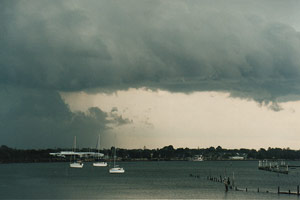
Click on any image to enlarge.
With a weeks
holiday spare I decided on a combined fishing / storm
chasing trip to the seaside town of Yamba on the north
coast of New South Wales. Yamba would be a better
situated base for potentially severe storms then my home
town.
The trip
takes 11 hours of driving. We left on Saturday 15th of
November at 4am. Thunderstorms were forecast in a trough
stretching across southern Queensland and into New South
Wales. A weak cold front had passed my home at 10pm the
previous evening. I knew that this front would stall
somewhere north of the Central Coast. This would enhance
storm activity. Next morning during the trip north, signs
of any front were completely gone by the mid north coast
town of Taree at 10.30am. There was however some patchy
rain in the trough area, to the west clearing had
occurred and already cumulus was forming in the clear
areas. However, the trip to Yamba took us through to the
other side of the trough which appeared not to be
favouring storm development. That evening a severe storm
advice had gone up for the mid north coast. At 9pm I
drove to a tall headland and could see lightning a long
way to the south.
Next morning was clear , very
warm and humid. The trough had moved over the north coast overnight,
and the middle level cloud had cleared. I filled in the morning fishing.
To the west I watched as several cumulus clouds grew over the Great
Dividing Range. By midday one of these had matured into a storm. The
most distinctive feature that caught my interest was the amount of pileus
cloud. At first just topping the tower, but later obscuring almost all
the cell except for the forward anvil
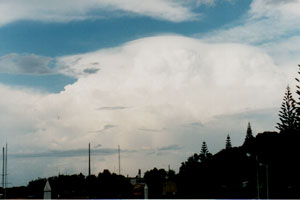 I kept an eye on the
storm over the next 2 hours whilst I took a refreshing swim at the beach.
The storm had moved almost to the coast by now. When it was close enough
to hear distant rumbles of thunder I decided it was time to think of
a possible chase. I raced to the cabin and grabbed my camera. In the
short few minutes that it took to get the camera gear several CG's on
the rain free north side of the storm had taken my attention. I decided
that the best option was not to chase as such, but stick right where
I was. I kept an eye on the
storm over the next 2 hours whilst I took a refreshing swim at the beach.
The storm had moved almost to the coast by now. When it was close enough
to hear distant rumbles of thunder I decided it was time to think of
a possible chase. I raced to the cabin and grabbed my camera. In the
short few minutes that it took to get the camera gear several CG's on
the rain free north side of the storm had taken my attention. I decided
that the best option was not to chase as such, but stick right where
I was.
This proved to be a fortunate
move. Whilst initially it was a round a CG's that grabbed my attention,
I now focused on a downdraft area to south west, the speed at which
it was moving and its general features indicated that possible downburst
activity was happening. I managed to get several good shots of this
powerful downdraft. I later learnt that this event caused widespread
damage to sugar cane crops at Palmers Island, completely flattening
large areas. There was some reports of minor structural damage and trees
uprooted.
 . .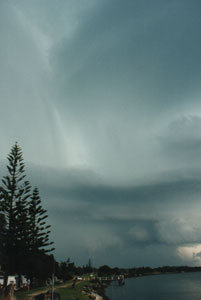
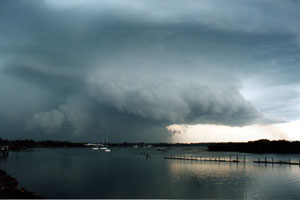 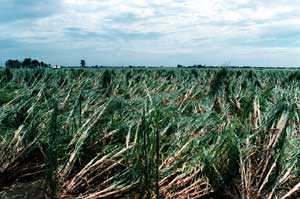
My view to the south was obscured by large Norfolk
Island pine trees, therefore I was taken by surprise when the odd large
hailstone started falling. I was expecting hail, ( see the portrait
photo ), but still thought I had about 10 minutes. I beat a hasty retreat
back to the cabin. Hail was a mixture of sizes from pea to around golfball.
Hail fell for about 2-3 minutes before any rain. The wind rose to about
40 knots. The storm lasted about 15 mins, before passing out to sea.
I was very surprised to see that the rear end of the storm ( see pileus
photo above ) was quite tame looking. I doubt that the storm was a supercell.
It appeared to be multi-cell for a start, I saw no rotation either.
Reports started filtering
in about the serious damage that this storm caused earlier at Grafton.
Local media reports indicate damage running to $3 million. This was
not counting any rural crop losses, only town damage. The Grafton suburb
of Junction Hill bore the brunt of the storm. This occurred at approx
1pm, a full two hours before the photos above. As well as numerous roofs,
some houses received major structural damage. Local estimates indicated
winds to 160kph.
 The
trip around the district later in the day showed that Yamba had been
spared the worst. At Palmers Island there were large areas of sugar
cane crop flattened. Where there were trees, leaf and twig litter was
almost completely covering most of the road. A few small trees had been
uprooted. I drove several kilometres southwards on Palmers Island and
all damage was straight line. Cane was laying east - north east, indicating
west to south west wind direction. Most of the photos above were taken
at Yamba looking up the Clarence River towards Palmers Island. The
trip around the district later in the day showed that Yamba had been
spared the worst. At Palmers Island there were large areas of sugar
cane crop flattened. Where there were trees, leaf and twig litter was
almost completely covering most of the road. A few small trees had been
uprooted. I drove several kilometres southwards on Palmers Island and
all damage was straight line. Cane was laying east - north east, indicating
west to south west wind direction. Most of the photos above were taken
at Yamba looking up the Clarence River towards Palmers Island.
Driving home a week later and I noticed that the small town
of Ulmarra had also seen severe winds. To the east of town many casuarina
trees lining the Clarence River had been uprooted.
EYE
WITNESS REPORT
by Ian Wright
The storm lasted only 16 minutes at
Junction Hill, my Davis Instruments
weather monitor, redgistered wind speed at 206 km before
it was taken out
of service by flying rubbish, the temperature
droped from 36.6c to
19.4c in 12 minutes prior to the storm, the
Brisbane weather beau. radar
said the storm was picked up at 21km high just prior to
the "down burst",
only marble sized hail was seen here but the amount was
stagering. in one
place there was 2qubic metres of hail in a 5 Square meter
area, I have a
great photo that I'm sending to Michael Bath taken form
the side of the
storm at about 1 1/2km from it"s centre just seconds
after the Down Burst
hit the ground I may be able to get you a copy if you can
give me an
address to post to.
I have been a weather watcher for a long time now and
have never seen
anything like this event. I spent 25 years in the
State Emergency Service
10 yrs. as controller of a unit and have never witnessed
anything so severe
before, if I can be of any further help please
contact me on this email
add.
ian@key.net.au
  
|